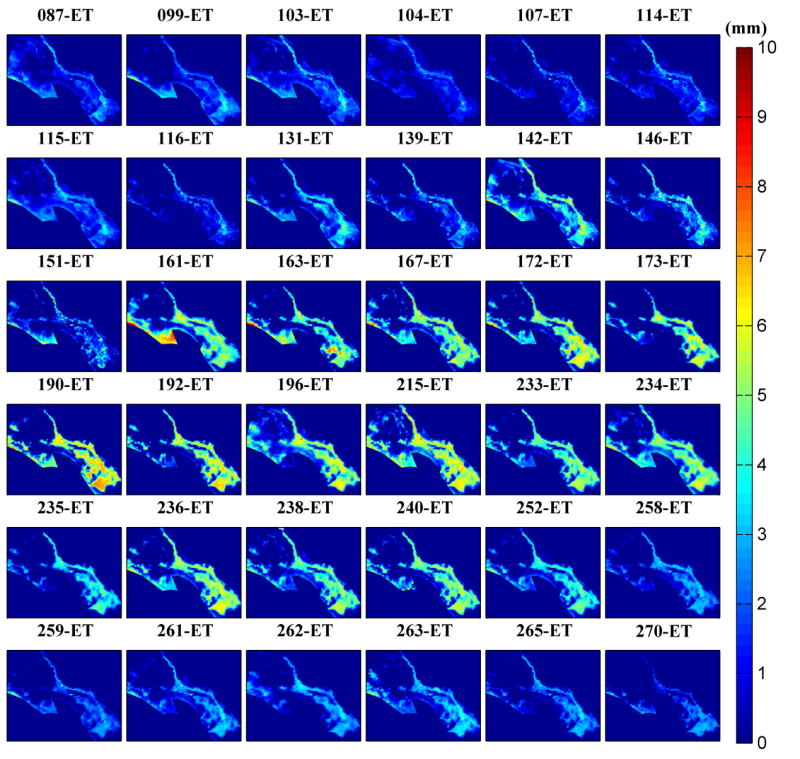Remote sensing inversion product of diurnal evapotranspiration in the middle reaches of Heihe River (2012)

Evapotranspiration monitoring is very important for agricultural water resource management, regional water resource utilization planning and sustainable development of social economy. The limitation of traditional monitoring et method is that it can't be observed in large area at the same time, so it can only be limited to the observation point. Therefore, the cost of personnel and equipment is relatively high. It can't provide the ET data of different land use types and crop types. Remote sensing can be used for quantitative monitoring of ET. the feature of remote sensing information is that it can reflect not only the macro structural characteristics of the earth's surface, but also the micro local differences.
This data uses MODIS data and m-sebal model from June to September 2012 and time scale expansion scheme based on reference evaporation ratio to estimate the spatial and temporal distribution of evapotranspiration in the whole growth season of the middle reaches of Heihe River, and uses ground observation data to evaluate m-sebal model and time scale expansion scheme in detail.
Its time resolution is day by day, spatial resolution is 250m, and data coverage is in the middle reaches of Heihe River, unit: mm.
The projection information of the data is as follows: UTM projection, 47N.
Data Citations
Related Literatures:1. Zhou, Y.Z., Zhou, J., Li, Y., & Wang, X.F. (2014). Simulating the evapotranspiration with SEBAL and Modified SEBAL (M-SEBAL) models over the desert and oasis of the middle reaches of the Heihe River. Journal of Glaciology and Geocryology, 36(6), 1526-1537.(View Details)
Cite as:Zhou, Y., Zhou, J. (2015). < b>Remote sensing inversion product of diurnal evapotranspiration in the middle reaches of Heihe River (2012)</b>2015. doi: 10.3972/heihe.10004.2014.db. (Download the reference: RIS | Bibtex )
Using this data, the data citation is required to be referenced and the related literatures are suggested to be cited.
Terms of Use
To respect the intellectual property rights, protect the rights of data authors, expand services of the data center, and evaluate the application potential of data, data users should clearly indicate the source of the data and the author of the data in the research results generated by using the data (including published papers, articles, data products, and unpublished research reports, data products and other results). For re-posting (second or multiple releases) data, the author must also indicate the source of the original data.
Related Resources
1.HiWATER: the albedo in the middle reaches of the Heihe River Basin (Jun. 29, 2012)
2.Grassland interception dataset of Tianlaochi watershed in Qilian Mountain
3.Datasets for the SWAT model in Heihe Rriver Basin
5.HiWATER: Airborne CCD image data in Hulugou Catchment
8.HiWATER: Airborne CCD image data in the Shenshawo desert area of the Heihe River Basin
No record
No record
Comments
Sign In to add comments
Keywords
- Discipline: 大气
- Theme: MODIS 大气遥感
- Places:
- Time: June to September 2012
Geographic coverage
| Spatial coverage |
East:102.0 South:38.5 |
West:98.5 North:40.5 |
|---|
Details
- Format: 栅格
- File size: 170.0 MB
- Browse count:14896
- Temporal coverage:2012-06-28 To 2012-10-27
- Access: Offline
- Updated time:2021-04-20
Authors
Resource Provider: ZHOU Yanzhao ZHOU Jian

 Copyright ©right; 2017 - 中国科学院西北生态环境资源研究院 - 兰州数云软件科技有限公司提供技术支持
Copyright ©right; 2017 - 中国科学院西北生态环境资源研究院 - 兰州数云软件科技有限公司提供技术支持